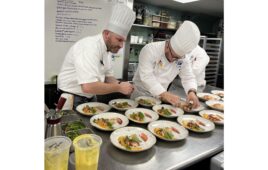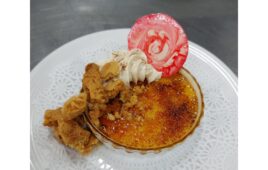
Everybody Wins With Wines by the Glass
No one can predict where the economy’s going with any certainty. But club and resort operators don’t need Alan Greenspan to help them read one economic barometer they can see at their properties every day: members and guests being much more thoughtful about how they’re spending their money.
That’s one reason dining room managers and wine directors are offering more and more good wines by the glass. Guests like how by-the-glass menus offer flexibility, the opportunity to try new things, and the possibility of drinking well but spending less. On the house side, glass pours are profitable, an effective way to enlighten novice wine drinkers and entice connoisseurs, and a great marketing tool for pricey bottles.
But to make a by-the-glass program work, the selections need to reflect a wide range of options, change often, and always taste as though the cork was just pulled.
Choose Wisely
Typically, wines by the glass tend towards mediocre, standard varietals, and moneymakers geared to those who aren’t serious or knowledgeable. But not at Addison, the signature restaurant of the Grand Del Mar Resort in San Diego.
|
SUMMING IT UP
• Glass pours please guests and generate profits for operators.• A good by-the-glass list offers variety in styles, regions, and price points. • Store open bottles with care, so the last glass is as good as the first. |
“We have a global perspective for our entire list,” says Jesse Rodriguez, the resort’s Wine Director. “That diversity is reflected in our extensive glass pours and half-bottles. On our menu, we showcase a mix of marquee producers and vintages, more approachable, affordable sleepers, and some step-up offerings.”
Fifty percent of Addison’s wine sales, he adds, are glasses and half-bottles.
Rodriguez, who holds certifications from both the Society of Wine Educators and the American Chapter of the Court of Master Sommeliers, uses his network of industry connections to source wines that can’t be found anywhere else in the San Diego area. Those contacts are especially helpful in sourcing half-bottles.
“It requires some homework,” he explains. “I contact labels directly to find out what’s available in that format, and even go to the ‘grey market’ to see what I can get from private sellers.”
Everything is served in specialty stemware, because Rodriguez believes it enhances the experience. “People come here to pamper themselves,” he notes. “We make it possible for them to do that with a $15 glass of something special.”
Good to the Last Drop
Franco Farroch, Food and Beverage Manager at Myers Park Country Club in Charlotte, N.C., includes 15 wines-by-the-glass on his club’s list. Labels and varietals that guests are likely to recognize are included, along with some that are a bit less familiar.
Farroch regularly attends tastings and visits wineries to find new vintages, focusing primarily on California varietals and other U.S. producers, because his customers prefer to buy American. And, he notes, even in this setting, he must remain price-sensitive.
 |
| Jesse Rodriguez, Wine Director at Addison, the signature restaurant of the Grand del Mar Resort in San Diego, makes half of his wine sales in glasses and half-bottles, showcasing “a mix of marquee producers and vintages, affordable sleepers, and step-up offerings.” |
“Members pay a great deal to be here and they expect a good deal in the dining room,” says Farroch, a certified sommelier. “We give it to them. Like many clubs, we double the cost on most bottles, but it’s still less than outside restaurants.”
Myers Park CC has an active wine society, and Farroch caters to these enthusiasts with a reserve list that features rare and expensive vintages. He also invests in some young wines for aging. But most of his wines are served by the glass in the casual dining room.
To preserve the contents of open bottles, staff members use a vacuum pump to remove all of the air. Unlike many by-the-glass servers, though, Farroch does not top off the opened bottles with nitrogen.
“Reds and whites are simply re-corked and stored in the cooler,” he notes. “The cold temperature slows down the process of deterioration, just as it does for milk or orange juice. Because red wine is not served chilled, nobody thinks about refrigerating it. But we pull them out to warm up when we arrive.” Dessert wines, he adds, are handled the same way.
Island Paradise
The Pineapple Grill at Kapalua Resort on Maui has earned recognition from Wine Spectator for its wine list. Chris Kaiwi, Managing Partner and Wine Buyer, focuses on selections from around the world that pair well with the kitchen’s Pacific Island cuisine while representing a variety of price points. Thirty-one vintages are available by the glass, and reds, whites, and sparkling wines are also offered in themed flights: American, European, and another selected region.
Kaiwi is convinced that his 24-spigot, temperature-controlled preservation and dispensing system is a key to his by-the-glass program’s success. It’s proven so popular that he’s added seven more individual pours, using canned gas to keep the opened wines fresh.
“One-third of our wine sales are by the glass,” Kaiwi says. “We change the lineup every three months, and prices are $8-$16. It’s part of how we educate people, and it’s helped us create a real wine culture among the locals.”
As an added draw, the resort offers discounts once a week. “On Wine Wednesdays, most bottles on the list are half off, and glasses are 25 percent off in the bar,” Kaiwi says.
Local residents, who comprise about 50 percent of the restaurant’s traffic, have been especially important to the resort during the economic downturn. Most of these customers work in the local hospitality industry and also generate business by recommending the Pineapple Grill to tourists.

 |
| One-third of the wine sales at Kapalua Resort’s Pineapple Grill are by the glass. The resort strives to keeps things fresh by changing the lineup every three months. The prices, however, always range between $8-$16. |
Taking Questions from the Floor
There are no descriptive notes on the eleven-page wine list at Teton Pines Country Club in Wilson, Wyo. Instead, Dining Room Manager and Wine Buyer Angie Morris is on the floor nightly to answer questions and give advice.
But not everyone needs her input. “Some of our clientele are set in their ways,” she admits. “They just want what they want and are definitely not interested in pairing wines with foods. It can be frustrating, but I’ve learned to accept it.”
In season, Morris offers 14 wines by the glass. She brings in rogue varieties like the white Bordeaux on her current roster, and changes the imports regularly. “Some people develop favorites,” she says. “There are things that just must stay on the list. The president of the club likes a particular wine, so it’s always available by the glass.”
Kevin Kenyon, Food and Beverage Manager at The Westmoor Club in Nantucket, Mass., has noticed that guests can have many reasons for choosing glasses over bottles. One new reason is that credit cards are now accepted in the club’s dining room. So when members bring guests and they’re going “Dutch,” wines by the glass make it easier to split the bill.
Another common cause is when patrons don’t want to commit to a whole bottle at the start of an evening. “They end up ordering so many glasses, they would have been better with a bottle,” says Kenyon. “But it’s great for us, because the margins are better.”
Additionally, for course pairings and when everyone at a table isn’t eating the same thing, ordering by the glass suits those who are matching reds with meats and whites with fish and chicken.
Interlachen Country Club in Edina, Minn., hired Chris Wallin as its Wine Director in September 2008. He’s made it his mission to get to know members and be guided by their preferences, rather than his own. He invites reps and wineries to put products on his by-the-glass list, which typically offers from 10 to 14 choices. He then solicits guests’ input.
He does the same for the five varietals he selects as house wines. “The list should not be about me. It’s about them,” he says.
Ultimately, Wallin has found, your wine list says a lot about what type of club you are and how you cater to your members and guests. A poorly-written list with a boring selection can be as bad for a dining room’s image as stale bread and dirty silverware. But an exciting list that shows creativity and imagination in the selection and presentation of wines will excite guests and waitstaff, and help create the elusive “buzz” that can set you apart—and get your club’s personal economy humming again.
|
Bottle Bargains
THE Westmoor Club in Nantucket, Mass., is only open for 90 summer days. So Food and Beverage Manager Kevin Kenyon can’t afford to make menu mistakes—and this year, the effects of the recession only increased the pressure.But Kenyon stepped up to meet the challenge largely through an aggressive and cost-conscious wine purchasing and promotion strategy. Westmoor’s wine revenues were much better than expected in June and July, thanks to Kenyon’s successful execution of these key steps in his action plan: • Focus on big names and recognizable labels that are easier to sell. • Keep the list diverse. Buy in limited quantities and when a vintage is gone don’t restock; replace it with something else. • Offer a rotating selection of wines at $15 above cost every week. • Price glasses to sell. Don’t try to make the first pour pay for the bottle. • Don’t hesitate to dicker over price or negotiate with vendors for the 100-case discount on 10 cases. • Avoid risks. Work with distributors who are willing to take product back. • Keep a close eye on your inventory. Order on an as-needed basis. |





Tell Us What You Think!
You must be logged in to post a comment.